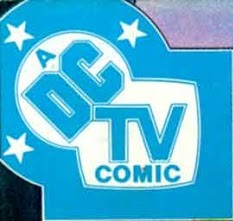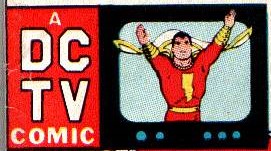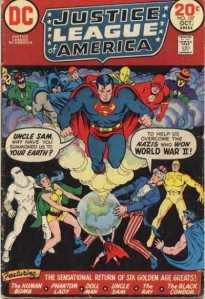DC’s Legends of Tomorrow just completed Season Two. And it will have a Season Three – something that was in doubt this time last year.
Season One was savaged by the critics and all but the most trollish of DC trolls. I liked it, I did. But I wasn’t as giddy about its first season as I was about the first season of Arrow or Flash … read my review by clicking on the link above.
This second season was better, per the critics and the trolls. And indeed it was.
I liked Season Two as well, but I still didn’t love it.
Why?
I have a hard time putting my finger on the why. And I figured out why while writing this review – which was partly my goal.
It was a better show than the prior season– they pruned the cast; the remaining members grew and the new ones were allowed more depth (a smaller cast allows that). They had a variety of Big Bads instead of one. The stories were fair despite the Pez-dispenser-like lessons of history.
Maybe it is unfair to compare it to the joy of watching Flash and Supergirl, where the glee (pardon the pun) of the cast and writers warm the viewers like the sun in spring. However, the show is better than the brooding and plodding Season Five of Arrow, which unfortunately followed its brooding and plodding Season Four.
Put it this way: I watch Flash and Supergirl as soon as I can (I tivo all my shows and watch them later) – usually the next day; with LoT I sometimes wait until the weekend; Arrow and some others (Agents of Shield, as another example) are watched in bundles of two or three episodes at a time because of their glacial story progression.
So LoT came in a distant third this year. The other CW shows have about six more episodes this season, so it is possible for them to blow it and make LoT look like the Mary Tyler Moore Show, but that is doubtful.
Let’s look at the hows and whys this season was better – or worse – than the first:
The cast was trimmed this season. Hawkgirl is gone. Too bad. Perhaps with this “new” setting of Season Two the character would have been able to do more than mourn the death of Carter Hall and be the constant captive of Vandal Savage. The actress Ciara Renée deserved better.
Arthur Darvill had other commitments during the season so Rip Hunter was written out of most of the show. I thought it would be the death knell but it actually helped. Sara Lance grew into the role of the captain of our crew. Rip’s eventual return just showed us how crowded the cast was – we and Rip realized he was … well … not needed anymore. I hope he pops up from time to time.
The loss of Wentworth Miller as Leonard Snart/Captain Cold was also a blow, or so I thought. Here was the best character of Season One (Mick Rory, now no longer Snart’s sidekick, steals every scene like the thief he is. The only good thing about Wentworth Miller leaving the show was Dominic Purcell’s ascendancy. He is wonderful – Rory was meant to be two-dimensional and ends up being the most well-rounded character of the show!).
Snart, Hunter and Hawkgirl were replaced by Steel and Vixen – two characters who started off in comics of the 1970s but did not really come into their own popularity until the 1980s. They helped provide some missing muscle and exposition (Steel was an historian and Vixen knew where to find this Season’s MacGuffin). They began a more believable romance than last year’s Atom-Hawkgirl coupling.
The Season starts out promising: the Legends’ job is to find time aberrations and set things straight: zombies in the Civil War, Albert Einstein kidnapped by Nazis. They confront the Justice Society (the handling of their roster caused quite a kerfuffle amongst the DC purists). Then the Big Bads and this season’s major MacGuffin are introduced:
The Legion of Doom consists of past bad guys from the Arrowverse – Eobard Thawn, trying to save his existence from being destroyed; Malcolm Merlyn – John Barrowman sleepwalking through this worn-out character; Damien Darhke, the Big Bad from Arrow Season 4, again played by Neal McDonough who smirked and smarmed as thoroughly as he did in Arrow. After 20 episodes there and 10 here, I think the audience has been sated with Darkhe, thank you. Wentworth Miller was touted as a member of the Legion, but he was only in the last three episodes or so.

The MacGuffin was the Spear of Destiny – a major prop in the DC comic book universe and a nice addition here – the spear the Roman soldier used to pierce the side of Jesus. In the comics, whosoever held the spear would rule the world. Hitler possessed it and prevented Superman and the other Justice Society members from going to Europe and kicking his ass (hence the reasoning behind why Superman, Dr. Fate, Green Lantern and others didn’t simply … go to Europe and kick his ass).
In LoT the Spear of Destiny can alter reality – Thawne wants it to create a universe in which his ancestor lived and thus he continued to exist. The Justice Society took the Spear and hid it throughout history. Thus creating the plot thread throughout the rest of the show, leading to a final big battle at the season’s end.
The season finale seemed almost tacked on. They go back to a previous adventure in World War One to change their eventual defeat that allows the Legion to take the spear – thus breaking the #1 temporal law – don’t go back and meet yourself (which some of the members had already done in Season One, but I assume, like Star Trek 5, we are to pretend that never happened).
Odd that Season Two only lasted 17 episodes instead of the usual 22 or 23, which may explain why the season finale seemed so “tacked on” – now that I bring it up, this plot thread could have been completed two or three shows before even that … heaven forfend they do some done-in-one episodes as filler. Subtract the obvious filler – the Jonah Hex redo and the cross-over with the other Arrowverse shows and we have only 15 episodes. Couldn’t the other 7 shows simply be well-done stand-alone episodes to finish out the season and prepare us for any changes in Season Three?
They COULD have done some fun single-episode time-travel shows. In my primer (the link is above) I mentioned they were entering into Doctor Who territory: going to different times and meeting the famous and infamous. They did that (George Washington, etc.), but it didn’t quite click.
The budget is tight on the show, I know. Which is why Firestorm rarely appears (and why wasn’t Victor Garber given more to do? After he revealed his daughter as a time aberration and turned over command to Sara Lance, he practically disappeared. Fortunately, he was excellent in the Flash’s musical episode!).
Brandon Routh was demoted from the eccentric he played in Flash down to the flightiness of last season to now being an idiotic man-child. Brandon Routh and Ray Palmer deserve better. He and Stein should be the geniuses of the series; like Cisco and Winn, creating the weekly MacGuffins to help defeat the bad guy.
On the other hand, Franz Drameh’s Jefferson Jackson was promoted from last season’s wise-ass kid to the engineer. He should be helping the geniuses Palmer and Stein with the mechanical side of the MacGuffin-making.
***
OK, so what was it about Season Two that I did not like? While I still haven’t quite put my finger on it, I do have some ideas to heal the show’s ills:
The Berlanti method is growing thin. After five seasons of Arrow, three in Flash, and one in LoT, the Season-long Big Bad story arc is an idea whose time is over. Do what is being done in Supergirl and make the Big Bad only a major recurring (not constant) villain – as they did with Lillian Luthor/Argus and Rhea (Mon-El’s mother). Weren’t you tired of Thawne snatching victory away from the Legends at the end of every episode?
Go back to fixing time aberrations. Not just on earth but through the universe. If you are going to emulate a TV show, you can do worse than Doctor Who. Introduce Kanjar Ro as an intergalactic tyrant. Introduce Krona as a time-meddler (he would make a good Big Bad AND be a nice way to FINALLY introduce the Green Lantern Corps into the Arrowverse)
Make “small” story arcs. The only good thing Agents of Shield has done in three years is having two separate story arcs this season – Ghost Rider for the fall and LMD for the spring.
And although the budget is not huge, PLEASE hire an historian. A real one. Nothing ruins a good story when you know the very premise is wrong. I realize this isn’t PBS, but stop using a paragraph or two from Wikipedia to get the gist of your background material.
For example: In one episode they had to find JRR Tolkien in the trenches of World War One. Tolkien knew a possible location to the tomb of Sir Gawain that could lead the Legends to a vial of the Jesus’ blood which could be used to destroy the Spear of Destiny … that lived in the house that Jack built. The Legends knew this because of a book Tolkien wrote about Sir Gawain. No such book exists – he wrote a translation of a lay of Sir Gawain, but not a treatise. And not during/before WWII…
While searching for him, they overheard a sergeant yelled “Fool of a Tolkien” to a sick soldier. Aha! This must be JRR! And sure enough …
The line was an homage to the line “Fool of a Took!” from Fellowship of the Ring. I bristled when I heard the line. It took away from Tolkien’s ability as a writer. It implied that he did not create the line – he just used what other people did. He did not. That is wrong.
“Lighten up,” you might say, “it was just a fun line.”
No it wasn’t. It was disrespectful. Same as when the Legends met George Lucas and the characters ended up in a pre-replica of the trash compactor scene. As with the Tolkien quotes, it diminished the genius and the originality of Lucas’ idea – a young lad and some friends are whisked away from their home by a quirky wizard to go fight a dark lord and his minions who are bent on ruling the … oh…
Never mind …
But it insults our intelligence as it insults the creativity of the historical guests (this is the same problem I have with Forest Gump or the “Marvin Berry” scene in Back to the Future).
Knock it off. It turns idols into thieves and it’s a short-cut by piss-pour writers for a cheap laugh.
***
As I hoped, writing this little opinion piece has revealed what nags me about the show: if Legends of Tomorrow weren’t connected to the comic book characters I read and loved as a kid, I would not be interested in watching this show.
Compare that to, say, the superb first season of Arrow. I’d have loved that season even without the superhero lineage.
(Whereas Flash and Supergirl are too inextractibly linked to their comic books to say that. Were anyone to make those two shows renaming their leads they would face a copyright lawsuit faster than you can say “Shazam”. That’s a great line if you know the history of comic book litigation…)
But I repeat – I would likely not watch LoT if not for the DC roster. The stories and characters may not be great – but it’s the Atom! And the Justice Society! It may insult my intelligence – but there’s Jonah Hex!
***
So I still like the show. Perhaps the reason it gets under my skin so is that with some really simple (and inexpensive) tweaks it could be so much better. Instead of being fun in a frat-boy-“that-was-cool-wasn’t-it” way it could be fun AND thrilling. Season Two was an improvement over Season One. Season Three could be better still!
I cheer for the show – I really am rooting for it to do well; to be better! Stop emulating the storytelling-style of Arrow and Flash. You don’t need to. Do shorter story arcs! Do solo stories focusing on only one or two characters! When they meet real life legends – let them remain legends, not accidents.
Don’t emulate others. Be different.
Most legends are…
Original Material Copyright 2017 Michael Curry
Characters mentioned and their images are copyright their respective holders. Thanks to DC Comics, the CW Network and Berlanti Productions and the actors portrayed for the use of their images.
I also thank the original creators of all characters mentioned, whether or not they have been properly compensated (gratmens during the credits aside).
















